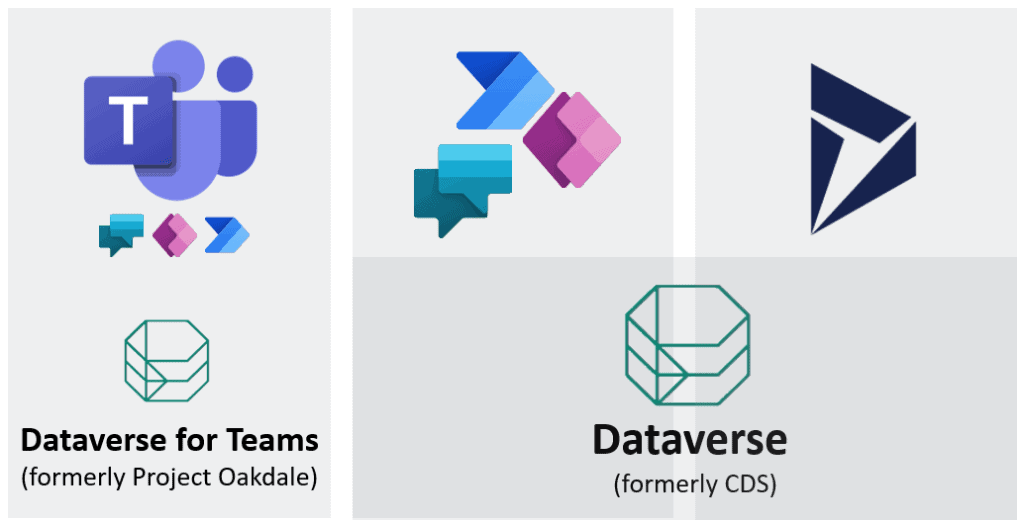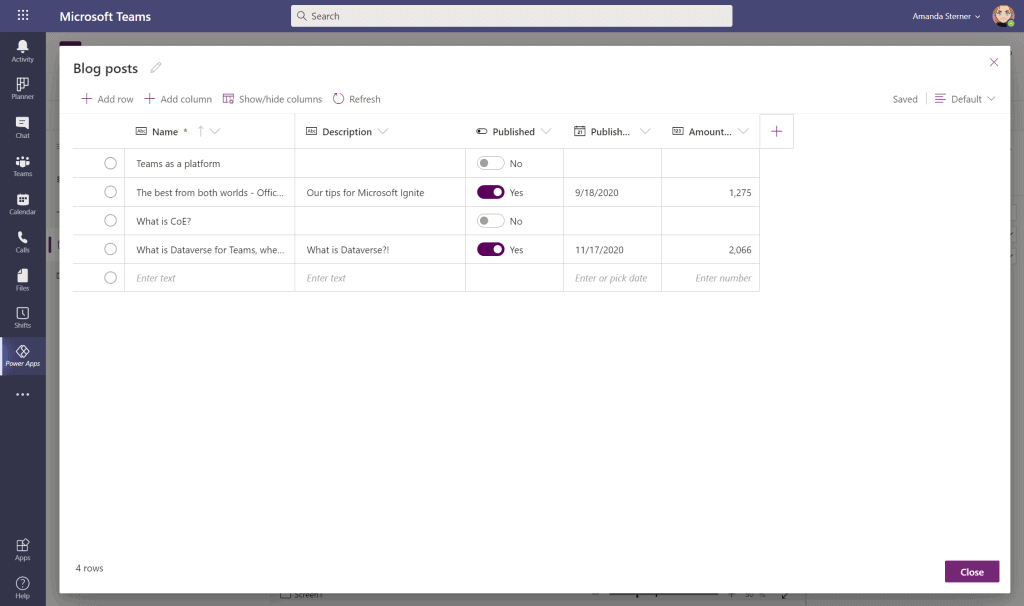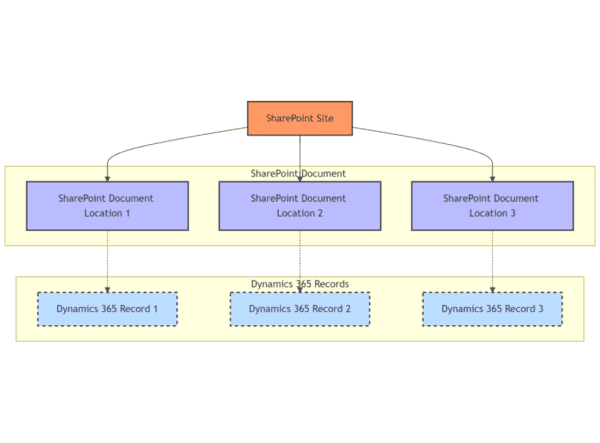A few weeks has passed since Microsoft Ignite and me and Amanda last spoke about our two worlds colliding. To refresh your mind; Amanda is working with productivity, collaboration and Microsoft 365 and you can find her blog here. Our previous common article had the title “The best from both worlds – Office Apps & Services and BizApps combined”. Our different worlds are colliding for sure and today we will look at examples of how the boundaries have been blurred.
Today we are back with another blog post since Microsoft announced the new official name for what we temporarily called Project Oakdale – say hello to Microsoft Dataverse for Teams. . Here you can read more about Microsoft Dataverse and Microsoft Dataverse for Teams and here about the news. In Microsoft Docs you find chapters about Dataverse here and Dataverse for Teams here.
From different silos to Teams as a platform
Before we get into Dataverse for Teams and the future, let’s get back even further. If we look a few years back (and not even that far), Business Applications and the world of collaboration were two completely separate worlds with people seldom talking to each other about their different areas of expertise. We had two different products (Microsoft Dynamics CRM and SharePoint) and most of the times we worked separately with those two.
It happened we needed to combine our worlds even back then. One example is when there was a need for a more comprehensive document management system to be used with Microsoft Dynamics CRM, rather than storing files directly in the database. However, even if there was such a thing called out of the box (OOTB) integration between those two, it was still two different silos.
Then something happened. Since the emergence of Power Platform and Microsoft Teams slowly turning into a platform (more about that in another post ) it has been evident that we cannot ignore that fact that we need to work together!
“The fact that our different worlds become closer and closer is equally scary and thrilling, it just makes it obvious that we cannot work in silos and need to collaborate to get the absolute best solutions to our customers“, says Amanda.
“Yes, a total identity crisis! I come from a world with xRM in the center of attention and where it was possible to have a deep understanding for most parts of one platform. Things are evolving so fast these days and you simply cannot know it all as deep as you could before. We sure need to collaborate even more now.” says Carina.
Let’s get back to where we are today, Dataverse for Teams, and let’s look at some of the things we need to think about for this new situation. In this article we will talk about what’s good for what, try to give you a few examples of how we can work together to create even better solutions, a few examples of when we are better apart and hopefully ending with making you more excited to combine Business Applications and Microsoft 365 with the help of Dataverse for Teams!
What is Dataverse for Teams?
Back in the Microsoft Dynamics CRM days we built entity models and data was stored in Entities (called Tables today), Entities were related to each other and had Fields (called Columns today) of different data types. When Microsoft moved their Business Applications suite to the cloud, we got Common Data Service (CDS). CDS is now Dataverse and Dataverse for Teams, well, that’s the “lite” version of Dataverse.
Dataverse for Teams – What is it? What is it good for? It’s basically a database in the cloud (but more) and we create data models in it which then can be used for our apps when we need to store data. It’s very user friendly and not as scary as a “database” might sound if you do not have a technical background. You create what is called “Tables” and you define what Columns there should be, what kind of data should be stored in each Column and you do all this INSIDE of Microsoft Teams. With Dataverse for Teams you will get one database for one team, which will live as long as the team lives. With Dataverse you do NOT work inside of Microsoft Teams.

So, what’s the difference with Dataverse for Teams and just Dataverse? The biggest difference is that Dataverse for Teams doesn’t have the full functionality of Dataverse, for example Dataverse have non-relational storage (logs) and Dataverse for Teams does not, Dataverse has API access and plugins and Dataverse for Teams does not. With Dataverse for Teams, access is restricted to just the Team owners, members and guests. If you compare with Dataverse, with Dataverse you have additional security features such as field level and hierarchical security, sharing and auditing. More differences are found in detail in Microsoft Docs. You can read about all the differences here. There is also another great link in Microsoft Docs which brings up all you need to know about environments and Dataverse for Teams, you find it here.
Dataverse for Teams means that parts of the Power Platform have moved into Microsoft Teams. We now have a “lite” version of Dataverse (former CDS) and we have the possibility to create Power Apps apps, Power Automate flows and Power Virtual Agents bots from within Microsoft Teams – using the licenses we already have with Microsoft 365 – cool, isn’t it?

When to use Dataverse for Teams and when not to
But wait a minute – so now we have Power Apps, Power Virtual Agents and Power Automate in Microsoft Teams, so when shoasfduld we use these in Microsoft Teams and when should we use them OUTSIDE of Microsoft Teams?
First of all, what are your needs? Are we talking about productivity apps to be used by yourself or a few chosen people or business critical apps to be used by an entire organization? An example of a productivity app is when you do something manually today, e.g., managing information in an Excel sheet, which might as well be managed in a Power App. It might be just for you or an app to share with a few colleagues. An example of a business-critical app is an app which is critical for your business – your business cannot function without it.
When to use Dataverse for Teams
- You do not use Dynamics 365 and the licenses that you currently have is for Microsoft 365 and you want to get started in a small scale with Power Apps. Think scalable – start with Dataverse for Teams and with the licenses you already have – then move to Dataverse at a later stage if there is a need for that.
- When you want to create a chat bot for your organization. Create a Power Virtual Agent chat bot in a team channel for free utilizing your Microsoft 365 licenses. As some of you might remember, the licensing for Power Virtual Agents are quite expensive (as mentioned in this old blog post by me/Amanda) so this is really a fantastic opportunity to build simple bots included in the price you already pay! This is a good start if you want to have a look at PVA for Teams.
- You do a lot of manually work today and you want to get started with the Power Platform in order to organize things better and skip a few manual steps. You simply have the need for “Productivity apps” or to automate tasks with Power Automate in a small scale. It can be apps or flows for your own or to share with a few colleagues. This is a good start if you want to look at Power Apps for Teams.
- If you want to get started with automation in a small scale or use flow for your Power Apps in Teams – take a look at Power Automate and all the connectors to be used. This is a good start.

When not to
- With Dataverse for Teams there is a limit in storage capacity, 1 million rows or 2 GB. If you know from the start that you will need to manage more data than that, then you should consider Dataverse instead. It is also good to know that you can start with Dataverse for Teams and then move up to Dataverse. (Good to know is that there is also a limitation in number of Teams with Dataverse environment, 500).
- Beware of what integrations you want to make, you need to take a look at what is possible with Dataverse for Teams and what is not. Recently Microsoft announced the possibility to use Azure API Management and create a connector with just a click to “Export to Power Apps/Power Automate”. This works also with Dataverse for Teams. This opens up the possibility e.g. to create custom APIs and easily create a custom connector which will work also for your Power Apps in Teams.
- When you use Dataverse for Teams everything you build will be connected to a team, a bot is connected to a team, a Power App is connected to the team. Power Apps cannot currently be shared outside the team it is built for, Power Virtual Agents bots can be shared to an entire organization but if the team is removed then the app/flow/bot will be removed. You need to be cautious about what team is the owner as each team will be responsible for the database.
- You need to be aware of the fact that there is something called “Premium connectors” and you might not have the license for using it. Make sure you know which connectors are included and which aren’t in Dataverse for Teams. It can get really expensive .
Conclusion
With Dataverse for Teams comes great opportunities, all of a sudden we can build business applications within Teams and start with the licenses that we already have with Microsoft 365. However, we need to stay alert to make well-though-of decisions. You need to think carefully about your needs and if someone else in the organization might have the same need. And now we also need to make sure we understand each other.
What we all can agree on is that it becomes even more important for us consultants to talk to each other and collaborate more, especially with those that complement our primary area of expertise!
About the Authors:
Carina
I’m Carina Claesson, a Power Platform Solution Architect living in Sweden. I’ve been working with Dynamics CRM/365 CE since 2009 and with other CRM systems since 2006. During my work days I come across all kinds of tricky things. On this blog I share my findings whenever I believe other people can benefit from it.
Amanda
Amanda Sterner works as a modern workplace specialist at Avega Group. Amanda’s favourite feeling in her job is when she can see on a person that they’ve actually understood how a new way of working can benefit them. For the last couple of years Amanda has been working with the modern workplace and more recently focusing on Microsoft Teams and how it can make the daily work life easier. Blogs at http://www.amandasterner.com about Microsoft Teams and how to use it and tweets here.
Reference:
Claesson, C. (2020). What is Dataverse for Teams, when to use it and when not to? Available at: https://carinaclaesson.com/2020/11/17/what-is-dataverse-for-teams-when-to-use-it-and-when-not-to/ [Accessed: 2nd March 2021].
Find more great Power Platform content here.










